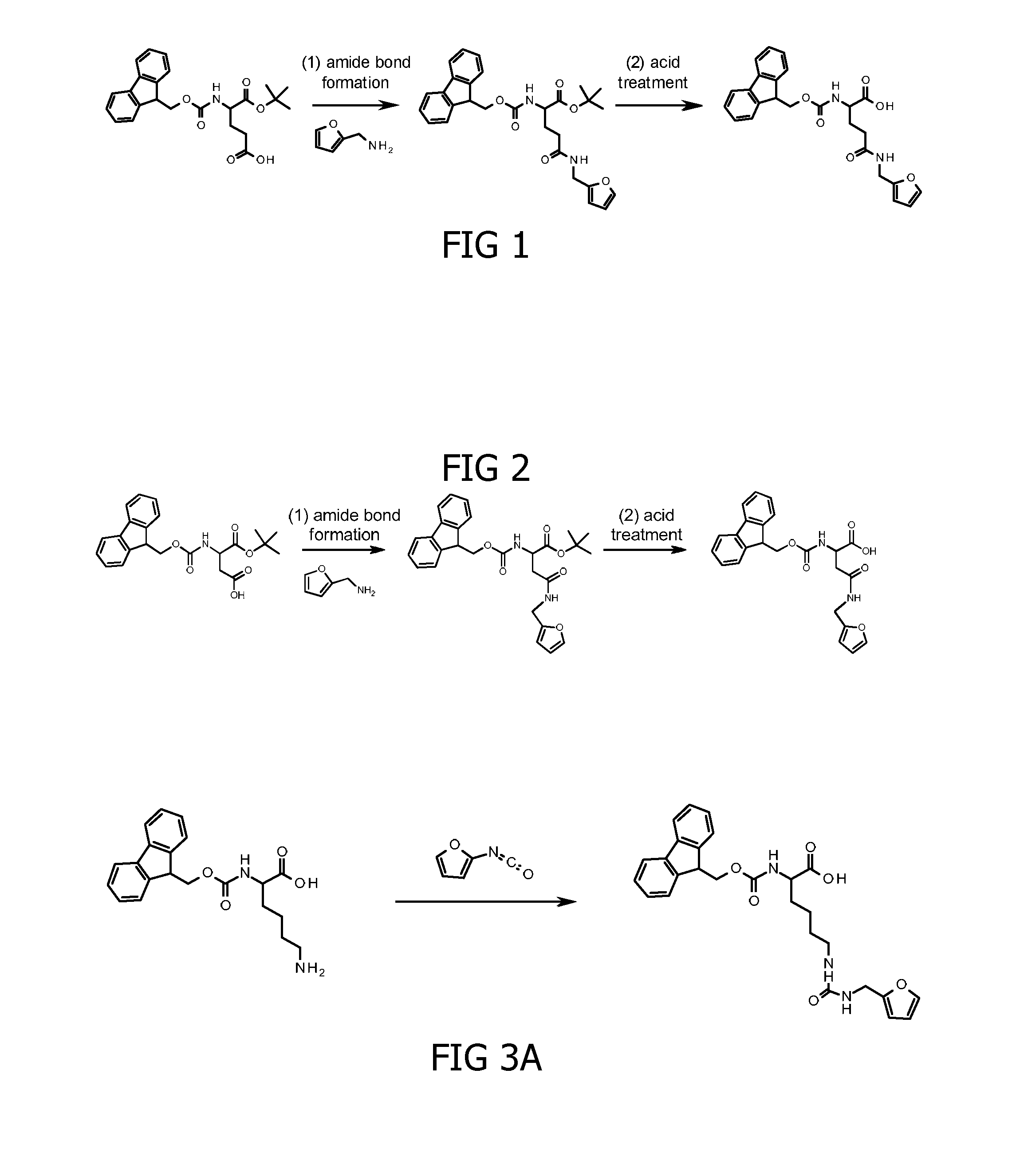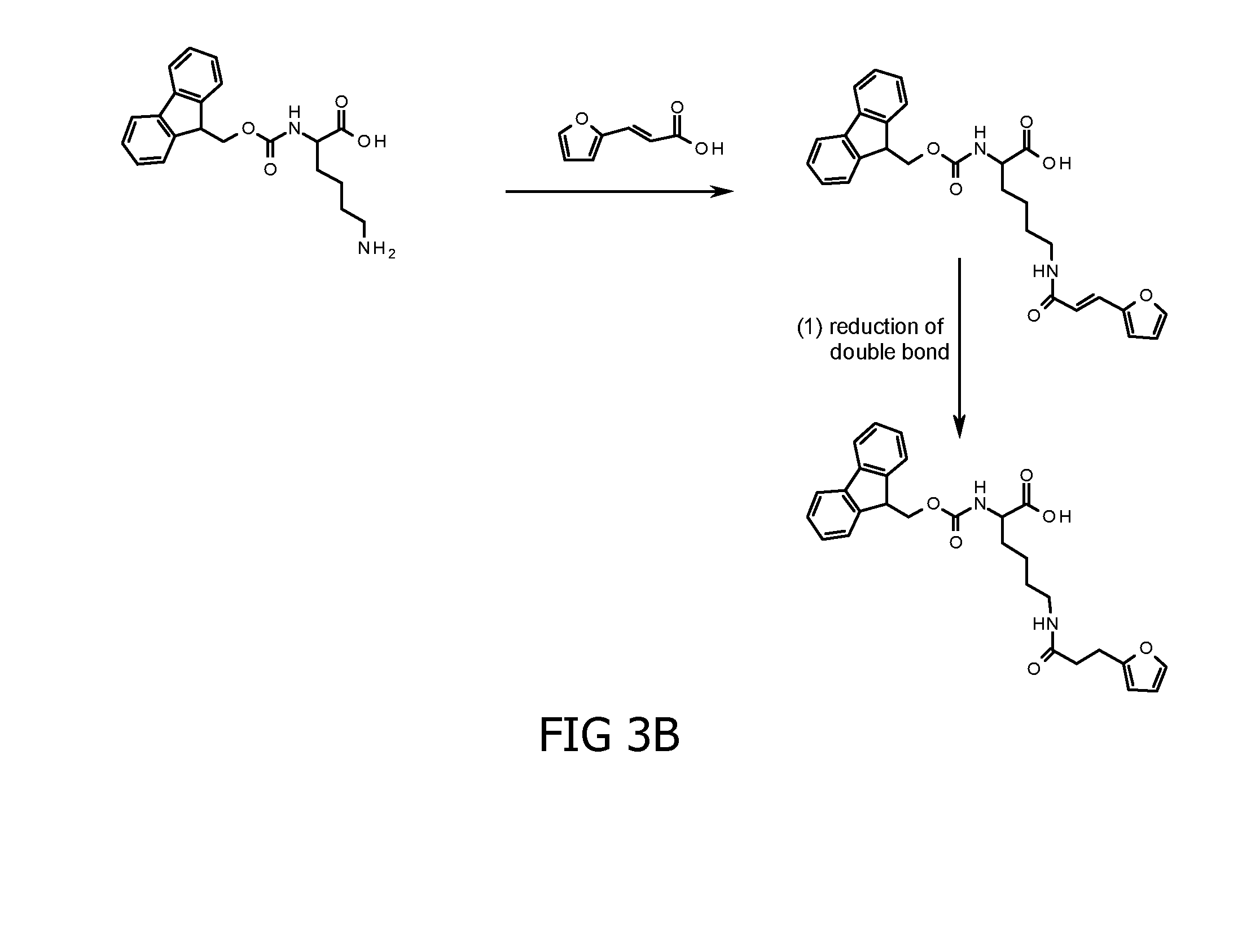Method for cross-linking peptides
a cross-linking and peptide technology, applied in the field of cross-linking peptides, can solve the problems of many different complex products, different types of starting materials, and difficult analysis of traditional methods for protein-protein or ligand-receptor studies, and achieves advantageously preventing damage to the peptides, high efficiency and specificity
- Summary
- Abstract
- Description
- Claims
- Application Information
AI Technical Summary
Benefits of technology
Problems solved by technology
Method used
Image
Examples
example 1
Synthesis of Furan-StrepTagII Peptides in Solution
[0166]In order to show the cross-link between peptides, an in vitro model system based on the interaction between the StrepTagII and streptavidin was used. The first available Strep-Tag (AWRHPQFGG) able to bind streptavidin could only be attached to the C-terminus of a protein. By changing the sequence of the Strep-Tag, a StrepTagII was developed that can be both N-terminally and C-terminally modified without losing its affinity for streptavidin. Because the intermolecular interactions between the StrepTagII and streptavidin are well characterized, StrepTagII-streptavidin is an excellent model for testing cross-linking. Furthermore, biotin binds streptavidin on the same binding site as the StrepTagII and with a much higher affinity. Biotin will therefore specifically inhibit the StrepTagII-streptavidin interaction.
[0167]A first objective was the synthesis of free furan-peptides in solution and furan-peptides bound to a solid support ...
example 2
Synthesis of Solid-Phase Bound Furan-Strep-TagII Peptides
[0170]In an aspect, furan-peptides bound to a solid support were synthesized.
[0171]Synthesis of a StrepTagII with N-terminal (2-furyl)-alanine capped with 2-naphtoic acid was performed with SPPS on a ChemMatrix® solid support as shown in FIG. 10. The ChemMatrix® solid support may be an Aminomethyl-ChemMatrix®. The amino acids of the StrepTagII were automatically coupled. Fmoc-(2-furyl)-alanine was subsequently coupled to the StrepTagII followed by Fmoc deprotection with piperidine in DMF and capping with 2-naphtoic acid. Deprotection of the amino acid side chains was performed by shaking for 1 h in a mixture of TFA, TIS and water. As a result, the solid-phase bound, N-terminal furan-StrepTagII peptide 6.3 was obtained.
[0172]Synthesis of a 2-naphtoic acid-StrepTagII with C-terminal (2-furyl)-alanine was performed with SPPS on a ChemMatrix® solid support as shown in FIG. 11. Synthesis of an acetyl-StrepTagII with C-terminal (2-f...
example 3
Oxidizing a Furan-StrepTagII to an Activated Furan-StrepTagII with N-Bromosuccinimide (NBS)
[0174]Different activating agents were tested for their ability to activate the furan-peptides. In first instance, N-bromosuccinimide (NBS) was tested as activating agent. NBS was added as an activation signal to free C-terminal furan-StrepTagII peptides 5.3, synthesized as described in Example 1. One equivalent of NBS was sufficient to selectively oxidize the furan-moiety of 5.3 to a reactive enal-moiety in phosphate buffered saline (PBS). As shown in FIG. 13, a major amount of the activated free C-terminal furan-StrepTagII had the desired molecular weight reduced with the molecular weight of water. This reduction in molecular weight could be due to intramolecular imine bonds which could form between the opened furan-moiety and the neighboring Lys amino acid. Also a minimal amount of over-oxidation was observed, probably due to oxidation of the indole ring in Trp. Unexpectedly and advantageou...
PUM
| Property | Measurement | Unit |
|---|---|---|
| distance | aaaaa | aaaaa |
| distance | aaaaa | aaaaa |
| distance | aaaaa | aaaaa |
Abstract
Description
Claims
Application Information
 Login to View More
Login to View More - R&D
- Intellectual Property
- Life Sciences
- Materials
- Tech Scout
- Unparalleled Data Quality
- Higher Quality Content
- 60% Fewer Hallucinations
Browse by: Latest US Patents, China's latest patents, Technical Efficacy Thesaurus, Application Domain, Technology Topic, Popular Technical Reports.
© 2025 PatSnap. All rights reserved.Legal|Privacy policy|Modern Slavery Act Transparency Statement|Sitemap|About US| Contact US: help@patsnap.com



